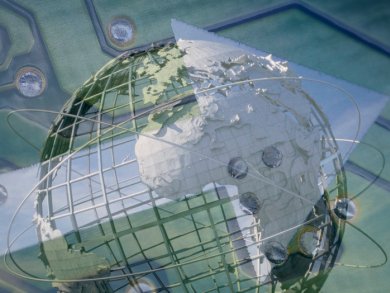The linear “Take – Make – Dispose” processes that characterize how goods like food, fresh water, and energy are currently used have caused major environmental, economic, and social problems such as climate change, resource scarcity, and pollution. So far, the role of technology has been mainly to improve the efficiency of these linear production processes, significantly increasing the unit of output by unit of input.
The real challenge lies in moving away from a linear to a circular production system, where “waste” is re-introduced into the production chain, greatly minimizing the need for raw materials and the impact on the environment. This is no longer an option, but an urgent need as our demand for natural resources, strategic minerals, and energy continues to increase dramatically.
Reducing water, energy, and raw materials bills makes sense, so why is the circular economy not already a reality? In some cases, it is: We use recycled paper, cans, bottles, car components, and even water. To expand on these existing product circles, emerging technologies are critical. To make circular processes economically viable, disruptive technologies play a key enabling role. For example, producing clean abundant hydrogen by splitting water using solar light, which can be used as a fuel that produces only water and by this closing the circle.
Emerging technologies are difficult to forecast. Nobody really knows which will close the loop of our production chains.
The World Economic Forum’s Global Agenda Council on Emerging Technologies, which launched its top ten emerging technologies in 2012, identified the ten most promising technology trends that can help to deliver sustainable growth in future decades. These are technologies that the Council considers have made development breakthroughs and are now nearing large-scale deployment.
Top Ten Emerging Technologies 2013
1. OnLine Electric Vehicles (OLEV)
Already widely used to exchange digital information, wireless technology can now also deliver electric power to moving vehicles.
In next-generation electric cars, pick-up coil sets under the vehicle floor receive power remotely via an electromagnetic field broadcast from cables installed under the road. The current also charges an onboard battery used to power the vehicle when it is out of range. As electricity is supplied externally, these vehicles only need a fifth of the battery capacity of a standard electric car. They can achieve transmission efficiencies of over 80 %. Online electric vehicles are currently undergoing road tests in Seoul, South Korea.
2. 3-D Printing and Remote Manufacturing
Three-dimensional printing allows the creation of solid structures from a digital computer file. If objects can be printed remotely at home or in the office rather than requiring time and energy for transportation, it potentially revolutionizes the economics of manufacturing.
The process involves layers of material being deposited on top of each other in order to create free-standing structures from the bottom up. Blueprints from computer-aided design are sliced into cross-sections for print templates. By this, virtually-created objects can be used as models for ‘hard copies’ made from plastics, metal alloys, or other materials.
3. Self-healing Materials
One of the defining characteristics of living organisms is the inherent ability to repair physical damage. A growing trend in biomimicry is the creation of non-living structural materials that also have the capacity to heal themselves when cut, torn, or cracked.
Self-healing materials that can repair damage without external human intervention could give manufactured goods longer lifetimes. They can reduce the demand for raw materials, as well as improve the inherent safety of structural materials used in construction or to form the bodies of aircraft.
4. Energy-efficient Water Purification
Water scarcity is a worsening ecological problem in many parts of the world due to competing demands from agriculture, cities, and other human uses. Where freshwater systems are over-used or exhausted, desalination of seawater offers a nearly unlimited water source. However, at the same time considerable use of energy – mostly from fossil fuels – is necessary to drive the evaporation or reverse-osmosis systems.
Emerging technologies offer the potential for significantly higher energy efficiency in desalination or purification of wastewater, potentially reducing energy consumption by 50 % or more. Techniques such as forward-osmosis can additionally improve efficiency by utilizing low-grade heat from thermal power production or renewable heat produced by solar-thermal or geothermal installations.
5. Carbon Dioxide Conversion and Use
Long-promised technologies for the capture and underground sequestration of carbon dioxide have yet to be proven commercially viable, even at the scale of a single large power station. New technologies that convert the unwanted CO2 into saleable goods can potentially address both the economic and energetic shortcomings of conventional Carbon Dioxide Capture and Storage (CCS) strategies.
One of the most promising approaches uses biologically engineered photosynthetic bacteria to turn waste CO2 in low-cost, modular solar converter systems into liquid fuels or chemicals. Individual systems are expected to reach operational scales of hundreds of acres within as little as two years. Being 10 to 100 times as productive per unit of land area, these systems address one of the main environmental constraints on biofuels from agricultural or algal feedstock. They could supply lower carbon fuels for automobiles, aviation, or other large-scale liquid fuel users.
6. Enhanced Nutrition to Drive Health at the Molecular Level
Even in developed countries millions of people suffer from malnutrition due to nutrient deficiencies in their diets. Modern genomic techniques have been applied to determine at the gene sequence level the vast number of naturally consumed proteins which are important in the human diet. The proteins identified may have advantages over standard protein supplements in that they can supply a greater percentage of essential amino acids. They also can have improved solubility, taste, texture, and nutritional characteristics.
The large-scale production of pure human dietary proteins based on the application of biotechnology to molecular nutrition can deliver health benefits such as in muscle development, managing diabetes, or reducing obesity.
7. Remote Sensing
The increasingly widespread use of sensors that allow passive responses to external stimulae will continue to change the way we respond to the environment, particularly in the area of health. Examples include sensors that continually monitor body functions – such as heart rate, blood oxygen and blood sugar levels – and if necessary trigger a medical response such as insulin provision.
Advances rely on wireless communication between devices, low power-sensing technologies and, sometimes, active energy harvesting. Other examples include vehicle-to-vehicle sensing for improved safety on the road.
8. Precise Drug Delivery Through Nanoscale Engineering
Pharmaceuticals that can be precisely delivered at the molecular level within or around the cell offer unprecedented opportunities for more effective treatments while reducing unwanted side effects. Targeted nanoparticles that adhere to diseased tissue allow for the micro-scale delivery of potent therapeutic compounds while minimizing their impact on healthy tissue, and are advancing in medical trials. After almost a decade of research, these approaches are finally showing signs of clinical utility.
9. Organic Electronics and Photovoltaics
Organic electronics uses carbon-based materials such as polymers to create electronic circuits and devices. In contrast to traditional, silicon-based semiconductors that are fabricated with expensive photolithographic techniques, organic electronics can be printed using low-cost, scalable processes such as ink jet printing. This makes them extremely cheap compared with traditional electronic devices, both in terms of the cost per device and the capital equipment required to produce them.
While organic electronics are currently unlikely to compete with silicon-based conductors in terms of speed and density, they have the potential to provide a significant edge in terms of cost and versatility. The cost implications of printed mass-produced solar photovoltaic collectors, for example, could accelerate the transition to renewable energy.
10. Fourth-generation Reactors and Nuclear Waste Recycling
Current once-through nuclear power reactors only utilize 1 % of the potential energy available in uranium, leaving the rest radioactively contaminated as nuclear waste. Whilst the technical challenge of geological disposal is manageable, the political challenge of nuclear waste seriously limits the appeal of this zero-carbon and highly scalable energy technology.
Spent-fuel recycling and breeding uranium-238 into new fissile material – known as Nuclear 2.0 – would extend already-mined uranium resources for centuries while dramatically reducing the volume and long-term toxicity of wastes. The radioactivity of the waste will drop below the level of the original uranium ore on a timescale of centuries rather than millennia. This makes geological disposal much less of a challenge and arguably even unnecessary and nuclear waste a minor environmental issue compared to hazardous wastes produced by other industries.
Fourth-generation technologies, including liquid metal-cooled fast reactors, are now being deployed in several countries and are offered by established nuclear engineering companies.
Javier García-Martínez is a member of the Global Agenda Council on Emerging Technologies, along with Director of the Molecular Nanotechnology Lab at the University of Alicante, Spain, and founder of Rive Technology.
- World Economic Forum, Geneva, Switzerland
Also of interest:
- The 2012 Top 10 Emerging Technologies,
ChemistryViews.org 2012.
Top 10 most important technologies that will impact on the state of the world in the near future - Javier García-Martínez on the Commercialization of Research,
Vera Köster,
ChemViews Magazine 2012, December.
DOI: 10.1002/chemv.201200143
How do you form a spin-off company from your research? J. García-Martínez talks about his experiences and how he finds time for his many roles



